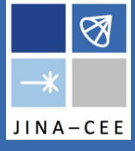Speaker
Dr
Duncan Galloway
(Monash Centre for Astrophysics, Monash University)
Description
Observationally, the wide variety of thermonuclear (type-I) bursts from accreting neutron stars present a challenge to modellers. Several aspects of the phenomenology are contrary to the predictions of even the most sophisticated numerical models, including irregular bursting behaviour, a decreasing burst rate with accretion rate (for some sources), and bursts recurring after an insufficiently long time to reach ignition conditions. Even for the best-behaved sources, the attempts to match observations to numerical models in detail have been limited, due both to the computational cost and the difficulty for modellers to access fully-analysed observational data.
In this talk I will report on ongoing efforts to address these problems. On the observational side, the first release of the MINBAR sample, including more than 7000 bursts from 85 sources, is planned for mid-2018. I will review the properties of the sample and some of the key data that is anticipated to contribute most significantly to efforts to match with numerical model. The MINBAR data have revealed a dependency of the bursting behaviour with accretion rate on the neutron star spin, which is not currently understood. I will also present a brief update of new results achieved with recently-launched instruments including NICER, HXMT and ASTROSAT.
In parallel we have been undergoing extensive testing of different numerical models, to understand differences between their predictions. We find that a commonly-used approximation for the nuclear energy generation in bursts substantially overestimates the energy lost in neutrinos, and have derived an improved expression based on detailed numerical simulations. Such simulations can also serve to populate a library of predictions for neutron star ash compositions. These simulations are critical inputs to software tools being developed to comprehensively match models to observations, including accounting for astrophysical uncertainties as well as addressing the high computational cost of detailed 1-D models.
We anticipate that these efforts will allow us to quantify in details the typical model uncertainty related to simulations of thermonuclear bursts, and potentially also will reveal important differences between model codes that need to be addressed. Ultimately, establishing burst-model comparisons as a viable method to constrain the rates of individual reactions will offer complementary measurements to nuclear experiment.
Primary author
Dr
Duncan Galloway
(Monash Centre for Astrophysics, Monash University)
Co-authors
Ms
Adelle Goodwin
(Monash University)
Prof.
Alexander Heger
(Monash Centre for Astrophysics)
Mr
Zac Johnston
(Monash University)
